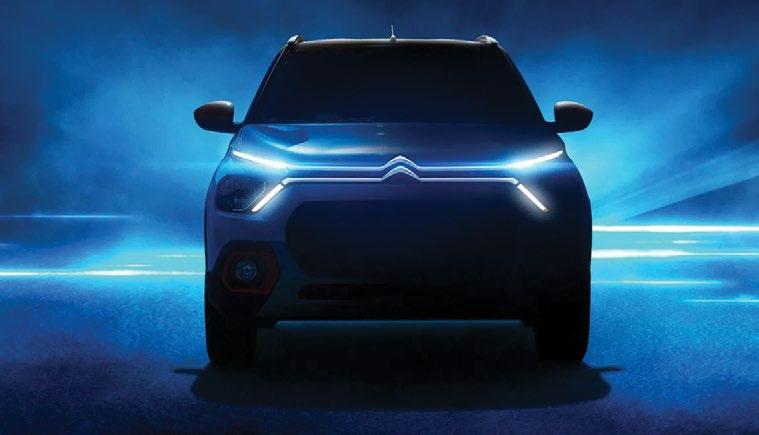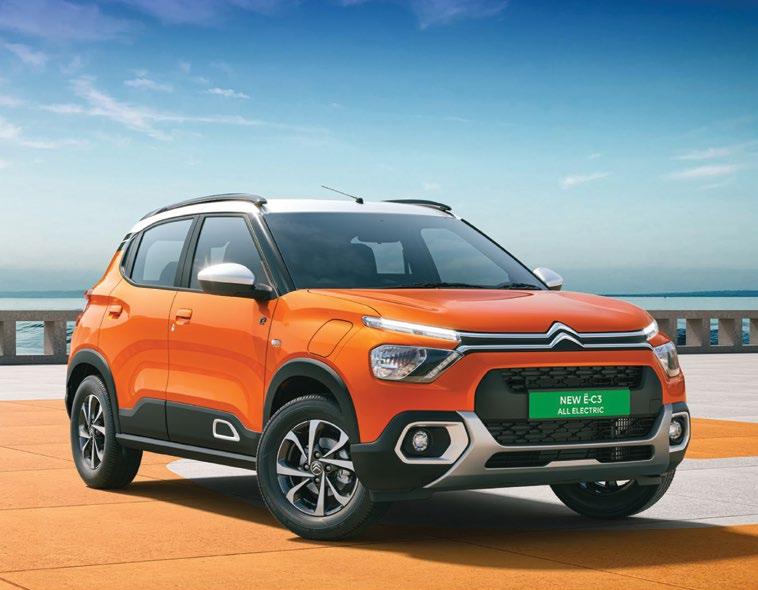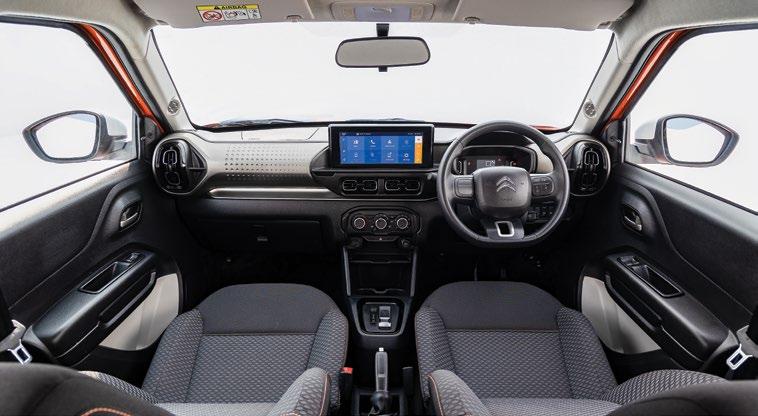
3 minute read
Citroen eC3
Citroen promised a model onslaught and they seem to be delivering on that with the new C3 electric.
The new eC3 is their most significant launch this year aimed at the budget end of the EV market and plugs the gap between the Tiago EV and Nexon EV. We sample one, although briefly, on a test track in Chennai and here are the initial impressions.
Advertisement
From the outside, there is very little to tell the eC3 apart from the petrol versions. The right-side front fender has a charging port, there are a few badges and that’s it. Citroen has always maintained that the C3 is a hatchback and not an SUV like everything these days. It was designed to have an EV variant right from the beginning. The eC3 has its battery pack underneath which reduces the ground clearance from 180 to 170mm. The Citroen eC3 has a 2540mm wheelbase which is the biggest in its class, as a result of which, the battery pack sits as one unit under the floor, unlike the split arrangement in a Tiago. The floor height inside the cabin has gone up by 70mm though. The boot remains uncompromised at 315 litres and there is a spare wheel underneath.
The interiors are the same with 10-inch touchscreen taking centre stage. It has logically laid out menus, support for wireless Apple Car Play and more functionality this time around. The drive selector is a toggle switch that looks neat. The small LCD screen for the driver is basic and now shows range and battery percentage. There is a manual day and night mirror now, but no climate control, no keyless entry, no push button start, height adjustable seat belts, rear AC vents, no reverse camera, no electrically adjustable mirrors, no rear wash/wipe or defogger. The front seats have a smaller frame, but are very decently padded with good under-thigh support. The rear seat has lots of support but due to the raised floor, passengers now have to sit knees up.
Powering the eC3 is a 29.2kWh battery pack that’s air-cooled rather than liquid-cooled. Citroen proudly says the development of the eC3 took only six months so it is yet to see a summer. Long-term reliability and how the battery performs in hot weather needs to be seen.
Powering the eC3 is a 29.2kWh battery pack that’s air-cooled rather than liquid-cooled. Citroen proudly says the development of the eC3 took only six months so it is yet to see a summer. Long-term reliability and how the battery performs in hot weather needs to be seen. Batteries mainly heat up during charging and discharging and in the eC3, charging speeds and motor power output have been restricted a fair bit. The motor produces only 57bhp but it’s torquey, with 143Nm. It is slow off the line and performance gets slightly better after it picks up speed to about 40kmph. The top speed has been limited to 107kmph. Since it was a test track, we couldn't test the real-world usability of the motor. Citroen says you can fast charge it as many times as you like and the battery can take it. Charging from 10-80 percent takes an hour in a DC fast charger and 10-100 percent takes 10.5 hours in a 15A wall socket. We expect it to do 210230kms on a full charge. It should be adequate for most people looking for a city hatchback.

With a stiff chassis, mature dynamics, and a willing engine, you can have a lot of fun with the C3.

What complements the engine is a good chassis. They have given it very good suspension compliance which combined with the 195/65
R15 tyres and a good amount of suspension travel, can take on any bad road. It is so composed on broken roads, it almost feels like a rally car underneath. While it’s no C5, the ride is extremely supple for this segment, helped by the long wheelbase and the wide track. The steering isn’t the most precise unit around and the soft suspension makes it roll a bit, but the C3 is predictable and neutral around corners. With a stiff chassis, mature dynamics, and a willing engine, you can have a lot of fun with the C3.
In a segment where features are just as important as the price, the C3 loses out on even the basic amenities. For people who want to buy it as a city car, there is also no automatic transmission option. It is sad because underneath it is a solidly engineered car. The chassis is good, the suspension is excellent and the turbocharged engine is very likeable. We can't help but think that if Citroen did the engineering and took the car to Hyundai or Kia who would then add all the features, we would have ended up with the perfect small car. Now it all comes to how well they price it









